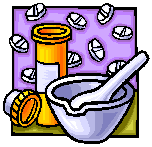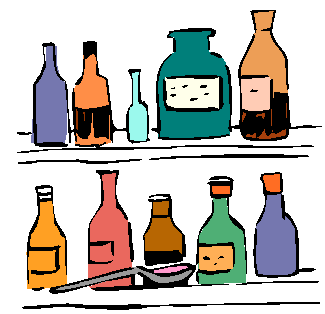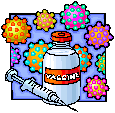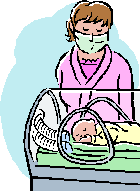DOH Medicaid Update November 2006 Vol. 21, No. 12
Office of Medicaid Management
DOH Medicaid Update
November 2006 Vol. 21, No. 12
State of New York
George E. Pataki, Governor
Department of Health
Antonia C. Novello, M.D., M.P.H., Dr. P.H.
Commissioner
Medicaid Update
is a monthly publication of the
New York State Department of Health,
Office of Medicaid Management
Brian J. Wing, Deputy Commissioner
Table of Contents
Mandatory Generic Drug Program
Medicare Part B Drug Coverage/Billing Issues
Medicare Part B Coverage of the Influenza Vaccination
Preferred Drug Program Fax Requests
Palivizumab (Synagis®) Coverage for Children at Risk for Respiratory Syncytial Virus Infections
Presumptive Eligibility Training
Approval of Darbepoetin Alfa (Aranesp) for Dialysis Patients
Using Serialized Prescription Forms for Medical-Surgical Supply Fiscal Orders
Rejection of Paper Claim Forms
ePACES Security Rules
Timely Submission of Claims to Medicaid
Prepayment Review has Ended for Procedure Code 92568
Fee Schedule Changes for Orthotics and Prosthetics
Replacement of the Uniform Billing Paper Claim Form
National Provider Identifier
HIV Primary Care Program Changes
Free HIV/AIDS Trainings
Seminar Schedule and Registration
Provider Services
Medicare Part D Wrap-around Benefit Changes
Starting January 1, 2007
Return to Table of Contents
Now is the time to act to assure your patient can obtain necessary drugs from their Medicare Part D Prescription Drug Plan.

Pursuant to recent legislation, effective January 1, 2007, the Medicaid Program will limit the wrap-around benefit for full benefit dual eligible recipients to the following four categories:
- Atypical anti-psychotics
- Antidepressants
- Anti-retrovirals used in the treatment of HIV/AIDS
- Anti-rejection drugs used in the treatment of tissue and organ transplants.
Note: New York Medicaid will continue to cover certain drugs which are excluded from the Part D benefit, such as barbiturates, benzodiazepines, some prescription vitamins, and some non-prescription drugs. These drugs may be billed directly to Medicaid.
Physicians & Other Prescribers: What You Need To Know
Physicians and other prescribers should anticipate a large volume of questions and phone calls from pharmacists and recipients regarding their drug needs; many of which have been met by Medicaid but will require coverage by Part D on January 1, 2007. Recipients will need your help to obtain medically necessary medications from their Medicare Part D plan.
Typical Medicare Part D drug coverage and formulary management issues which will require your assistance to resolve:
- Prior Authorization For The Covered Drug - contact the Part D plan.
- Quantity Limits - contact plan to obtain prior authorization/request exception to exceed plan limits.
- Step Therapy - contact plan to choose alternative/request exception.
- Non-Formulary Drug - switch/request exception to a covered drug
- Drug Is Covered Under Medicare Part B - put diagnosis, UPIN (Unique Physician Identification Number), location of administration (if nursing home, MD office) on Rx.
We strongly encourage prescribers and pharmacists to work with Part D plans prior to January 1, 2007 to obtain all necessary exceptions or prior authorizations in order to avoid interruptions in patients' drug therapy.

Pharmacists: What You Need To Know
Dual-eligible recipients should obtain medically necessary drug coverage from their Medicare Part D plans. However, many drugs are either not included in the Part D plan formulary or are subject to various formulary management restrictions.
Pharmacists can provide assistance to resolve drug coverage issues, including the following:
- Contact Part D plans to determine why drug claims are being
- denied and what can be done to meet the plans' coverage requirements.
- Work with prescribers to satisfy prior authorization, step therapy, quantity limit requirements.
- Identify alternative covered drugs.
- Pursue formulary exception requests.
Reminder: When billing Medicaid, all Medicaid rules apply to wrap-around benefit claims, including any Medicaid prior authorization requirements and co-payments. If the drug requires prior authorization under Medicaid, the prescriber and dispensing pharmacist must complete the Medicaid prior authorization process by calling (877) 309-9493.
Mandatory Generic Drug Program
Return to Table of Contents

Technical assistance for all pharmacy prior authorizations, including the Mandatory Generic Drug Program, is provided through the Prior Authorization Clinical Call Center.
Please Note: The instructions and worksheets for the Mandatory Generic Drug Program prior authorization program have been revised.
New York State Medicaid Program Prior Authorization Instructions and Worksheet For Prescribers - Mandatory Generic Program
New York State Medicaid Program Prior Authorization Instructions For Pharmacy Emergency Supply/Generic Unavailable
The updated prior authorization worksheets are also available online at:
www.nyhealth.gov or http://newyork.fhsc.com
For billing questions, call (800) 343-9000.
For clinical concerns or Mandatory Generic Drug Program questions, call (877) 309-9493
For Medicaid pharmacy policy and operations questions, call (518) 486-3209
Attention
Prescribers and Pharmacists
Medicare Part B Drug Coverage/Billing Issues
Return to Table of Contents
The Medicaid Program is often inappropriately billed for drugs covered through Medicare Part B. Claims involving such drugs must be billed to Medicare, the primary payor. Medicaid, as the payor of last resort, may only be billed for Medicare Part B coinsurance for these drugs. Because prescriptions for Medicare Part B covered drugs may not include sufficient information, it is often not readily apparent to pharmacists that a drug should be billed to Medicare.
Prescribers: You can help pharmacists identify Medicare Part B covered drugs by simply including the patient diagnosis, location of drug administration (e.g., prescriber's office, nursing home), and the provider's UPIN (Unique Physician Identification Number) on the prescription.

Common Drug Categories/Drugs That May Be Covered under Part B
- Inhalation medications administered via nebulizer (e.g., Albuterol, Atrovent, Duoneb, Pulmicort, Tobi, Xopenex).
- Blood modifiers (e.g., Aranesp, Epogen, Procrit).
- Cancer treatment drugs (e.g., Alkeran, Cytoxan, Myleran, Temodar, Vepesid, Xeloda, Rituxan, Lupron Depot, Emend, Kytril, Marinol, Zofran)
For more information on Medicare Part B drug coverage and billing, please go to:
http://www.cms.hhs.gov/PrescriptionDrugCovGenIn/Downloads/PartBandPartDdoc_07.27.05.pdf
or
www.cms.hhs.gov/Pharmacy/Downloads/partsbdcoverageissues.pdf
Medicare Part B Coverage of the Influenza Vaccination
Return to Table of Contents

This is the perfect time to talk to your patients about getting the flu shot. Medicare provides coverage for the flu vaccine and its administration. The influenza vaccination is a covered Medicare Part B benefit. Please encourage your Medicare patients to take advantage of this vital benefit.
Please Note: The influenza vaccine is NOT a Medicare Part D covered drug.
Preferred Drug Program Fax Requests
Return to Table of Contents
Prescribers...
Faxed requests for prior authorization of non-preferred drugs in the Preferred Drug Program (PDP) are permitted.
- Forms can be found at: https://newyork.fhsc.com/providers/PDP_forms.asp
- Be sure to complete all information before submitting the request, including clinical criteria for certain drugs.
- Fax completed forms to: 1-800-268-2990.
- Fax requests may take up to 24 hours to process.
Remember! If you prescribe the preferred drug, no prior authorization is necessary.
Faxed requests for prior authorization are not permitted under the Clinical Drug Review Program (CDRP) or the Mandatory Generic Drug Program.
Additional information on the PDP and the CDRP, including the most current Preferred Drug List, is available by calling the prior authorization Clinical Call Center at 1-877-309-9493, or by visiting:
www.nyhealth.gov or http://newyork.fhsc.com

Prior Authorization will not be issued to override maximum quantities, age or gender restriction indicators, or to prescribe medications not listed on the New York State List of Medicaid Reimbursable Drugs.
For clinical concerns or Preferred Drug Program questions, contact (877) 309-9493.
For billing questions, contact (800) 343-9000.
For Medicaid pharmacy policy and operations questions, call (518) 486-3209
FRAUD IMPACTS ALL TAXPAYERS.
Do you suspect that a recipient or a provider has engaged in fraudulent activities?
Please call:
1-877-87FRAUD
Your call will remain confidential.
Palivizumab (Synagis®) Medicaid Coverage For Children at Risk for Respiratory Syncytial Virus Infections
Return to Table of Contents

Palivizumab is an intramuscular injection used as prophylaxis for respiratory syncytial virus (RSV). It is used in certain high-risk children with histories of prematurity and chronic lung disease (CLD); formerly known as bronchopulmonary dysplasia. RSV is a leading cause of bronchiolitis and pneumonia in infants. Palivizumab should be administered at the start of the season, typically November, and monthly throughout the RSV season, ending in April.
GUIDELINES
The following are guidelines for identifying children who should be considered for RSV prophylaxis and are adapted from the American Academy of Pediatrics' Policy Statement1:

- •Infants and children less than 24 months of age with CLD who have required medical therapy for CLD within the past six months before the anticipated start of the RSV season.
- •Neonates born at greater than 28 weeks and less than 32 weeks gestation with or without CLD who are less than six months of age at the start of the RSV season.
- •Neonates born at 28 weeks of gestation or less with or without CLD and who are less than 12 months of age at the start of the RSV season.
- •Neonates born between 32 and 35 weeks gestation with or without CLD who are less than six months of age at the start of the RSV season only if two or more additional risk factors are present including: school-age siblings, child-care attendance, exposure to environmental air pollutants, congenital abnormalities of the airways or severe neuromuscular disease.
- •Children who are 24 months of age or younger with hemodynamically significant cyanotic and acyanotic congenital heart disease.
Palivizumab should not be used for the treatment of RSV disease.
REIMBURSEMENT AND PAYMENT
Medicaid reimburses for Palivizumab when billed by Medicaid-enrolled physicians, nurse practitioners and pharmacy providers.
Practitioner Billing
When billing the cost and administration of palivizumab, physicians and nurse practitioners should:
- Bill on paper claim forms.
- Use code 90749 (unlisted vaccine/toxoid), and include a copy of the vendor's invoice attached to the claim.
- Describe the patient name, product name and total dose administered on the vendor's invoice.
- Insert the acquisition cost plus a two-dollar ($2.00) administration fee in the "amount charged" field.
For more information on practitioner billing, refer to the Physician Provider Manual, Procedure Code and Fee Schedule page 109, version 2006-1 (4/1/06), available at:
www.emedny.org/ProviderManuals/Physician/index.html
Pharmacy Billing
Pharmacy providers should enter the Palivizumab NDC number into the online billing system as they would for any prescription pharmaceutical.
For further information on Medicaid coverage guidelines of Palivizumab, please contact staff:
Physician providers: (518) 473-2160
Pharmacy providers: (518) 486-3209.
For billing questions, please contact Computer Sciences Corporation at (800) 343-9000.
References:
1. American Academy of Pediatrics, Committee on Infectious Diseases and Committee on Fetus and Newborn. Policy statement: revised indications for the use of palivizumab and respiratory syncytial virus immune globulin intravenous for the prevention of respiratory syncytial virus infections. http://aappolicy.aappublications.org/cgi/content/full/pediatrics;112/6/1442
2. American Academy of Pediatrics, Committee on Infectious Diseases and Committee on Fetus and Newborn. Prevention of respiratory syncytial virus infections: indication for the use of palivizumab and update on the use of RSV-IGIV. Pediatrics. 1998;102:1211-1216.
3. Meissner HC, et al. Prevention of RSV infection in high risk infants: Consensus opinion on the role of immunoprophylaxis with palivizumab, a humanized respiratory syncytial virus monoclonal antibody for prevention of respiratory syncytial virus infection in high risk infants. Pediatr Infect Dis J. 1999;18 (3):223-231.
4. Synagis® (palivizumab) prescribing information. Medimmune, Inc., Rev. Approved Date Dec. 14, 2004.
(Rev. 9/06)
Presumptive Eligibility Training
Return to Table of Contents
As of October 10, 2006 training for eligible providers to determine Medicaid presumptive eligibility (PE) for pregnant women is now web based and available online at:

Previously, local social services districts were required to train eligible providers in this process.
Federal and State regulations allow only certain health care providers to make presumptive eligibility determinations for pregnant women. The Qualified Provider (QP) must be a New York State Department of Health (DOH) certified:
- Prenatal Care Assistance Program (PCAP);
- a local department of health or public health nursing service;
- an Article 28 clinic, free standing or hospital; or
- Certified Home Health Agency (CHHA).
Please Note: The video and workbook previously used by districts to train provider staff in presumptive eligibility are no longer valid.
Healthcare providers, who meet the QP qualifications and are interested in determining PE, must first complete the online training and then submit their application to the DOH. For inquiries regarding qualifications and applications for enrollment as a QP, access the DOH website at:
www.health.state.ny.us/health_care/medicaid/program/index.htm.
It is strongly recommended that currently enrolled QPs have their staff complete the PE online training as a refresher.
Questions? Please contact the Bureau of Maternal and Child Health at (518) 486-6562.
Attention
Dialysis Providers
Approval of Darbepoetin Alfa (Aranesp) for Dialysis Patients
Return to Table of Contents
Effective January 1, 2004, Medicaid approved the use of Darbepoetin Alfa (Aranesp), as an ordered ambulatory service, for patients receiving dialysis services.
Aranesp is payable using a procedure code as an ordered ambulatory service (OAS).
- Claims with service dates between January 1, 2004 and December 31, 2005 should be billed to Medicaid with procedure code Q4054;
- Claims with service dates on or after January 1, 2006 should be billed with procedure code J0882.
When Medicare is the primary payor, you should continue your current coinsurance billing practice of billing only the rate code claim which combines the facility session and the associated drug expense (Epogen or Aranesp) under rate code 3107. However, you will need to indicate both the hemodialysis procedure code and the drug procedure code on your Medicaid claim.
Prior to the addition of Aranesp to the OAS fee schedule, Epoetin Alfa (Epogen) was the only drug billable to Medicaid in conjunction with a hemodialysis session. Payment for Epogen is made using rate codes 1806 for freestanding facilities or 3106 for hospital-based facilities. Payment will be made for either Epogen or Aranesp during a session; both drugs cannot be billed. In addition, Aranesp is not payable under the Epogen rate codes.
Should you need to bill for Aranesp administered on or after January 1, 2004, please refer to the coding information above. To correct a claim for Aranesp billed under an Epogen rate code, void the Epogen claim and then submit, in a timely fashion, a new, Ordered Ambulatory claim using the appropriate procedure code noted above.
Information on the timely submission of claims to the Medicaid Program is included in the article on pages 16-17 of this publication.
As a continuation of this new billing policy for hemodialysis drugs, Epogen will no longer be billable as a separate rate code on or after January 1, 2007. Instead, as like Aranesp, it will be billed as an OAS using the procedure code J0886 effective as of January 1, 2007. The rate codes for Epogen will become inactive for dates of service as noted above.
Please Note: reimbursement for drugs administered by providers to their patients is based on the acquisition cost to the provider for the drug dose administered to the patient. For all drugs administered in this fashion, it is expected that the provider will maintain auditable records of actual itemized invoice cost of the drug, including the numbers of doses of the drug represented on the invoice.
Billing may be done on paper or via any of the HIPAA compliant electronic formats. For further information on billing, visit the eMedNY website http://www.emedny.org and review the OAS Provider Manual. In the future, please refer to your OAS fee schedule and the Medicaid Update for updated coding and billing instructions.
Questions? Please contact the Division of Medical Review and Provider Enrollment, Rate Based Provider Unit at:
(518) 474-8161.
Using Serialized Prescription Forms for Medical-Surgical Supply Fiscal Orders
Return to Table of Contents
A new Public Health Law designed to combat fraud went into full effect on April 19, 2006, requiring that all prescriptions written in New York State, for both controlled and non-controlled drugs, must be written on an Official New York State Serialized Prescription Form, with some exceptions. Instructions for billing were provided in the October 2006 Medicaid Update.

Serialized prescription numbers must be recorded on pharmacy claims in field 454-EK. An edit has been implemented at Computer Sciences Corporation, Medicaid's fiscal agent, which denies pharmacy NCPDP claims that do not include the serialized prescription number.
Serialized prescription forms may be used as Medicaid fiscal orders for medical-surgical supplies (e.g., diabetic supplies, enteral nutritional formula and incontinence products) when the following minimum information required for all supply fiscal orders is present:
- Name, Address and telephone number of the ordering practitioner;
- Name and Medicaid identification number of the recipient;
- Date ordered;
- Original signature of the ordering practitioner; and
- Name of item, quantity ordered, size, catalog number as necessary, directions for use, date ordered and number of refills, if any.
If the supply fiscal order is written on a serialized prescription form, pharmacies must enter in the serialized prescription number on the NCPDP claim.
Medicaid fiscal orders for supplies can continue to be filled and dispensed when not written on a serialized prescription form. When billing on the NCPDP claim for a supply fiscal order not written on a serialized prescription form, pharmacies must enter "SSSSSSSS" in lieu of a serial number.
Instructions for supplies billed on the 837P (pharmacy-medical equipment) claim remain unchanged: no entry of a serialized prescription number is required.
Questions? Please call Computer Sciences Corporation, Provider Services Section at: (800) 343-9000.
Missing Issues?
The Medicaid Update, indexed by subject area, can be accessed online at the New York State Department of Health website:
www.health.state.ny.us/health_care/medicaid/program/update/main.htm
Hard copies can be obtained upon request by emailing:
MedicaidUpdate@health.state.ny.us
Attention
All Providers
Rejection of Paper Claim Forms
Return to Table of Contents
If you submit paper claim forms to Computer Sciences Corporation for processing, this article will provide helpful information for preventing your claims from being rejected and returned to you, before processing, or denied due to lack of supporting documentation.
REJECTED CLAIMS
Paper claim forms are screened before submission to the Medicaid processing system for certain information and attachment requirements. When claim forms are rejected, a rejection letter is included. The letter has a facsimile of the claim form, and, for certain types of rejections, the appropriate area of the form will be circled to direct the provider to where the problem is on the claim.
The information below will assist providers in preventing rejections:
Missing Information

The claim forms must contain certain key pieces of information. Without this information the claim must be returned. The information includes the billing provider identification number, the client identification number and an appropriate original signature in ink (stamped signatures are not acceptable).
Illegible Information
If the client identification number and/or the provider identification number are not legible, the claim form will be returned.
Invalid Information
Invalid information refers to certain important data that is not in an appropriate format such as:
- The billing provider identification number must be eight numbers.
- The client identification number must be formatted as two (2) letters, followed by five (5) numbers, followed by one (1) letter. (example - AB12345C) Medicaid does not assign the letters I or O to any client identification number.
Unscannable Claim Forms
Claim forms are scanned and an electronic image is made for processing. Examples of unscannable claim forms include:
- Copies of claim forms
- Torn claim forms
Invalid Attachments
Only certain attachments are acceptable when submitted with paper claim forms. Common invalid attachments include:
- Any paper smaller or larger than 8 ½ by 11 inches
- Any attachment other than paper (example - dental x-rays)
- Claims over 90 days from the date of service with an attachment with OTHER THAN one of the following valid reasons for the delay:
- Litigation
- Medicare and/or other insurance processing delays
- Delay in Medicaid eligibility determination
- Rejection or denial of the original claim for reason(s) other than the 90 day rule
- Administrative delay in the prior approval process
- Interrupted maternity care
- IPRO denial/reversal
Please note: Inappropriate use of these reasons for delay could result in claim denial. Also, each claim form must have its own 90-day letter attached.
Other
Rejectable items in this category may include, among other things, the use of red ink, white-out correction fluid, correction tape or any stickers affixed to the form.
Questions regarding rejected claim forms should be directed to the eMedNY Call Center at: (800) 343-9000.
ATTACHMENTS OF SUPPORTING DOCUMENTATION
Some claims, such as "By Report" procedures, after being accepted for processing, require manual review for medical necessity and/or pricing by the Department of Health (DOH). When a claim is pended for manual review, the claim and all attachments are forwarded electronically to DOH for review. If upon review of the attachments, illegible or invalid information is found, the claim will be denied. Below are some of the most common problems with these claim attachments that will cause the claim to be denied:
Medical Documentation
- Documentation is often missing.
- Paper claim forms manually reviewed by DOH require patient name.
- Each page of documentation attached requires patient identification to match the claim form.
- Date(s) of service must be documented and must match the claim date(s) of service.
- Documentation provided does not identify the billing provider.
- Signatures of the attending practitioner are missing from documents or are illegible.
- Stamped signatures are acceptable/recommended on supporting documentation but only in addition to the written signature.
- Clinical information is inadequate or illegible.
- Clarifications of chart notes are acceptable, but not revisions.
- Underlining or circling pertinent information is acceptable but highlighting is not--highlighting obscures the image.
- Discharge summaries cannot be substituted for operative reports or individual chart notes.
Evidence of Acquisition Cost
- Copies of authentic vendor invoices must be provided.
- Internal itemized billing lists, packing lists, and/or "Informational Invoices" are not adequate evidence of cost.
- Specific items purchased must be identified (i.e., circled) without highlighting.
- The cost to the actual billing provider must be evident on the vendor's invoice ("Bill To" information).
- Purchase date on the invoice must be relevant to the date of service (not after & within shelf life expectancy).
- Vendor's invoice must identify a clear breakdown of the volume purchased versus the quantity dispensed/rendered (i.e., # of boxes within a case; # vials within box; mg or ml within vial).
- Calculations used to determine unit cost may additionally be presented on the vendor invoice to assist in review.
Questions regarding denials related to supporting documentation?
Please call the Division of Medical Review and Provider Enrollment at (800) 562-0856 option #3 for "Medical Pended Claims".
eMedNY
Update
ePACES Security Rules
User identification numbers that are shared by more than one person will soon be deactivated.
Return to Table of Contents
When a provider first establishes an ePACES account, the individual from your organization who first signed up for ePACES is granted special authority and is known as your ePACES Administrator. One of the important responsibilities of your Administrator is to enter the names of all other individuals who will create transactions via ePACES for a specific provider identification number. Unique ePACES User identification numbers are assigned to those individuals.
It is imperative that an Administrator NOT share his/her user identification number with other individuals. The same rules apply if an Administrator establishes a unique identification number for an individual, that individual MUST NOT share that number with any other person!
This is a requirement for HIPAA privacy regulations, as well as a NYS Medicaid requirement by the Department of Health.
If additional persons within your organization require access to ePACES, they can be easily assigned new user identification numbers and passwords by your ePACES Administrator. Your onsite ePACES Administrator is responsible for setting up individual user accounts with the proper access privileges.
It is highly recommended that every provider have more than one Administrator. A provider's initial Administrator can set up other individuals as additional Administrators. This practice will save you time and aggravation should the initial Administrator go on vacation or become disaffiliated with your organization/office.
Individuals share user identification numbers, and/or password information and who do not know the identity of their ePACES Administrator, should contact the number below to find out that information.
Questions regarding the ePACES Administrator functions or ePACES security?
Please call the eMedNY Call Center at (800) 343-9000.
Timely Submission Of Claims To Medicaid Return to Table of Contents
Medicaid regulations require that claims for payment of medical care, services, or supplies to eligible recipients be initially submitted within 90 days of the date of service to be valid and enforceable, unless the claim is delayed due to circumstances outside the control of the provider. Acceptable reasons for a claim to be submitted beyond 90 days are:

- Litigation
- Medicare and/or other insurance processing delays
- Delay in Medicaid eligibility determinations
- Rejection or denial of the original claim for reason(s) other than the 90-day rule
- Administrative delay in the prior approval process
- Interrupted maternity care
- IPRO (Island Peer Review Organization) denial/reversal
If a claim is denied, it must be corrected and resubmitted within 60 days of the date of notification to the provider. Claims not correctly resubmitted within 60 days, or those continuing to not be payable after the resubmission, are neither valid nor enforceable. In addition, all claims must be finally submitted to the fiscal agent and be payable within two years from the date the care, services or supplies were furnished in order to be valid and enforceable against the Department of Health (DOH) or a social service district.
Claims Over 90 Days Old, Less Than Two Years Old
All claims initially delayed over 90 days must be submitted within 30 days from the time the submission came within control of the provider. For paper claims, a cover letter for each claim must be attached which specifies one or more of the acceptable reasons noted above.
Please send all paper claims less than two years old directly to:
Computer Sciences Corporation
P.O. Box 4601
Rensselaer, New York 12144-4601
Please send the original claim form and retain a photocopy for your files. Claims submitted electronically must specify the appropriate late submission reason code. For valid coding, refer to the electronic billing instructions issued by the Fiscal Agent or the HIPAA 837 Companion Documents available at http://www.emedny.org/HIPAA/index.html .
Claims Over Two Years Old And Procedures For Requesting A Waiver Of The Two-Year Billing Regulation
All claims over two years old must be submitted directly to Computer Sciences Corporation within 90 days of the date submission came within control of the provider.
As part of the process, those claims will be automatically denied. A denial message (Edit 01292, Date of Service Two Years Prior to Date Received, or HIPAA reject reason code 29 or 187, the time limit for filing has expired) will appear on the provider's remittance statement or 835 electronic remittance advice. The Department will consider claims over two years old for payment only if the provider can produce documentation verifying that the cause of the delay was the result of one or more of the following:
- Errors by the Department,
- Errors by a local social services district, or another agent of the Department, or
- Court-ordered payments.
Requests for waiver of the regulation regarding submission of claims greater than two years from the date of service must then be received at the address below within 90 days of the release of the Medicaid remittance statement confirming the Two Year denial.
New York State Department of Health
Division of Medical Review and Provider Enrollment
Two Year Review Unit
150 Broadway, Suite 6E
Albany, New York 12204–1736
Supporting documentation (cover letter of explanation, remittance statements, notice of eligibility, fair hearing decision, court order decisions, evidence of agency error, etc.) and a copy of the current remittance statement documenting the Two Year delay and displaying the TCN number must accompany your written request. Any waiver requests received without the required information will be returned without further processing.
Adjustments to paid claims do not require a waiver of the Two Year regulation.
Claims Submitted for Stop-Loss Payments
Claims for stop-loss payment must be finally submitted to the Department, and be payable, within two years from the close of the benefit year in order to be valid and enforceable against the Department. For example, 2004 payable claims must be finally submitted no later than December 31, 2006 with corresponding cutoff for future years.
Questions regarding the processing, review or disposition of claims over two years old?
Please call (800) 562-0856, option #3.
Attention Practitioners and Ordered Ambulatory Providers
Prepayment Review Has Ended For Procedure Code 92568
Return to Table of Contents
The Division of Medical Review and Provider Enrollment has concluded its prepayment review on procedure code 92568 - Acoustic reflex testing; threshold.
Effective for dates of service on and after August 1, 2006, supporting documentation and paper billing will no longer be required as a part of this review. However, all services rendered during the period of May 1 through July 31, 2006, other than Medicare coinsurance claims, must continue to meet this requirement as originally presented in the April 2006 Medicaid Update.
Questions? Please contact the Division of Medical Review and Provider Enrollment's Medical Pended Claims Unit at: (800) 562-0856.
Fee Schedule Changes For Orthotics And Prosthetics
Return to Table of Contents
Please make the following changes, noted in BOLD, in your DME Fee Schedule (Rev. 4/1/06):
S1040 F2 Cranial remolding orthosis, rigid, with soft interface material, custom fabricated, includes fitting and adjustment(s) (p. 54). Effective for dates of service (DOS) on or after November 1, 2006, the price will be $1,105.89. The price includes three months of adjustments. Labor code E1340 may be billed only if adjustments are required more than three months after initiation of treatment.
L5984 F4 All endoskeletal lower extremity prosthesis, axial rotation unit, with or without adjustability (p. 88). Effective for dates of service (DOS) on or after November 1, 2006, the price will be $456.86.
Questions? Please contact the Division of Medical Review and Provider Enrollment at (518) 474-8161.
Attention
Rate-Based Providers
Replacement of the Uniform Billing Paper Claim Form
Return to Table of Contents
The Centers for Medicare and Medicaid Services (CMS) has announced that the Uniform Billing (UB-04) claim form will replace the current UB-92 claim form by the second quarter of 2007.
These claim forms are used by some institutional and rate-based providers to bill claims that are excluded from the mandatory electronic claims submission requirements to NYS Medicaid.
The new UB-04 form incorporates the National Provider Identifier (NPI), as well as some additional changes. These forms are commercially available, and must be purchased directly by the provider.
Providers who print these forms via a personal computer or computer program need to contact their software department or vendor to schedule a project to complete the coding for the new UB-04 form. CSC will make billing instructions available to providers in early 2007.
Only original claim forms can be processed.
In the near future, Medicaid will announce the date when providers may begin submitting UB-04's and will accept both the UB-04 and the UB-92 for a period of time to allow providers to transition to the new form.
Providers who are impacted by this change are urged to review future editions of the Medicaid Update and to frequently visit www.emedny.org as more details will be forthcoming about changes to the billing requirements for the UB-04 claim form.
Questions? Please contact the eMedNY Call Center at (800) 343-9000.
National Provider Identifier
Return to Table of Contents
Providers need to communicate their National Provider Identification (NPI) information to the New York State Medicaid Program as soon as possible.
The New York State Medicaid Program will be unable to process your electronic transactions if your NPI information has not been communicated by the implementation date.

Federal rules currently require that health care providers obtain an NPI prior to May 23, 2007 for all electronic healthcare transactions, such as claims and eligibility requests to the Medicaid Program. This means that providers (unless exempt from NPI) need to obtain an NPI as soon as possible, as the Medicaid Program needs the NPI information to continue to pay claims after the implementation date. To find out how to obtain an NPI, please visit:
www.cms.hhs.gov/NationalProvIdentStand
Once you have obtained your NPI, you need to report it to the Medicaid Program. You can do this online at:
There is a new "Enter NPI" button, (located in the green box) below the ePACES and eXchange buttons on the right side of the eMedNY home page. You will need to have your NPI(s) along with your Medicaid Provider Identification Number(s) and Tax Identification Number (social security number or employer identification number, as appropriate).
Information on reporting NPI(s) to the NYS Medicaid Program via this method can be found in the NPI Web Enabled Entry Reference Guide, which can be accessed from the NPI link located on the NYHIPAADESK welcome page. This reference guide is also available via CSC's Fax-on-Demand system. To have the document faxed to you, call (800) 370-5809 and order Document Number 7004.
Providers who bill electronically may currently submit their NPI information with their 837 claim transactions, but must follow the instructions above for entering NPI information via the web.
Questions? Please call the eMedNY Call Center at (800) 343-9000.
Would You Like Future Medicaid Updates Emailed To You?
Return to Table of Contents
Email your request, along with your provider identification number (found on the mailing address label of the update) to:
MedicaidUpdate@health.state.ny.us.
Please let us know if you want to continue receiving the hard copy in the mail, in addition to the emailed version.
Please Note: Requesting the email version does not remove you from our hardcopy list. You will only be removed from our hardcopy list if requested from you.
Important
Information
HIV Primary Care Program Changes
Return to Table of Contents
The visit structure for the HIV Primary Care Medicaid Program has been changed to reflect both advances in treatment and new public health strategies to prevent HIV transmission. A new Department of Health (DOH) Memorandum (AI06-01), which provides a full description of the revised program, was issued on September 22, 2006 and posted on the DOH website:
http://www.health.state.ny.us/diseases/aids/testing/primarycaremedicaid/index.htm.
The changes, which take effect on November 1, 2006, are summarized in the chart below.
The most notable changes are:
- the extension of the HIV Testing and HIV Counseling (Positive) visits to hospital emergency departments (EDs),
- the elimination of the Post-Test Counseling (Negative) and Drug and Immunotherapy visits, and
- revised utilization markers for HIV Counseling without Testing and HIV Counseling (Positive) visits.
The Department has revised the Agreement for the HIV Primary Care Medicaid Program to reflect these changes and others related to the elimination of training requirements for non-clinician HIV counselorsand to the requirements of the AIDS Institute's nationally recognized HIV Quality of Care Program. Health facilities currently enrolled in the program must sign and return the revised agreement by January 1, 2007 to continue billing under the Program. A copy of the new Agreement is included in DOHM AI06-01.
| Visit Description | D&TC Rate Code | Hospital Rate Code | Current UT* | November 2006 |
|---|---|---|---|---|
| HIV Testing | 1695 | 2983 | 2 | Extended to ED |
| HIV Counseling without Testing | 3109 | 3109 | 2 | 1** |
| HIV Post - test Counseling (Negative) | 1696 | 2984 | 1 Per Test | Visit Eliminated |
| HIV Counseling (Positive) | 1802 | 3111 | 2 Per Patient | 3 at Initial Diagnosis ___________ 1/yr Post Diagnosis |
| Initial - Annual Comprehensive HIV Medical Evaluation |
1697 | 2985 | 1** Per Year | No Change - 1** Per Year |
| HIV Monitoring | 1699 | 2987 | 4 Per Year | 3 Per Year |
| Drug and Immunotherapy | 1698 | 2986 | 4 Per Month | Eliminated |
| *Expected Visit Usage/Year **Maximum Visit Usage/Year | ||||
| Bold indicates 2006 changes | ||||
For additional information or for copies of the new DOHM AI 06-01, please go to:
http://www.health.state.ny.us/diseases/aids/testing/primarycaremedicaid/index.htm, or contact: HIV Primary Care Medicaid Program
Division of HIV Health Care & Community Services
New York State Department of Health AIDS Institute
Empire State Plaza, Corning Tower - Room 459
Albany, New York 12237
HIVPCMP@health.state.ny.us
Free HIV/AIDS Trainings
Return to Table of Contents
For providers who work with clients with HIV/AIDS, or are affected by HIV/AIDS, the Office of the Medical Director (OMD) is pleased to announce the Statewide Calendar of HIV/AIDS Training - Fall/Winter 2006 on the Department of Health website at:
http://www.nyhealth.gov/diseases/aids/training/docs/fall_winter2006.pdf
This website is regularly updated for providers to learn about new announcements, seminars and new training centers. In addition to the various trainings, OMD funds centers in multiple topics including;
- Behavioral Social Science,
- Case Management,
- Emerging Issues in Substance Use and Harm Reduction,
- Training-of-Trainers,
- Criminal Justice, and
- Program Evaluation.
Register for FREE trainings in your region by contacting the Training Center listed below. All trainings are free and many have CME/CEU, OASAS & Pharmaceutical Credits.
Learn more about trainings by requesting a training calendar in your region.
| Area(s) Served | Name | Address/Telephone | Website |
|---|---|---|---|
| New York City | AIDS Community Resource Initiative - ACRIA Cicatelli Associates, Inc. NDRI, Inc. |
230 West 38th Street 17 th Floor New York, NY 10018 (212) 924-3934 505 Eighth Avenue 16th Floor, Suite 1601 New York, NY 10018 (212) 594-7741 71 West 23rd Street 8th Floor New York, NY 10010 (212) 845-4550 |
www.acria.org http://www.cicatelli.org www.training.ndri.org |
| Long Island /Westchester | Center for Public Health Education AIDS Related Communitry Services |
Benedict House, SUNY 4016 Health Sciences Road Stony Brook, NY 11794-4016 (631) 444-3245 40 Saw Mill Road Hawthorne, NY 10523 (914) 785-8364 |
www.hsc.stonybrook.edu/shtm/cphe/index.cfm www.arcs.org |
| Southern Tier | Southern Tier AIDS Program | 122 Baldwin Street Johnson City, NY 13790 (607) 798-1706 |
www.stapinc.org |
| Finger Lakes & Western NY | Center for Health & Behavioral Training | 853 West Main Street Rochester, NY 14611 (585) 753-5382 |
www.urmc.rochester.edu/chbt or email chbt@monroecounty.gov |
| Central NY | Family Ties Network | 1010 James Street, 2nd Fl. Syracuse, NY 13203 (315) 424-0009 |
http://www.familytiesnetwork.org |
| Capital District & North Country | Professional Development Program (PDP SUNY Albany) | Rockefeller College/SUNY Albany 1215 Western Avenue, 4th Fl. University Administration Bldg. Albany, NY 12222 (518) 956-7876 |
http://www.pdp.albany.edu |
For information on these training opportunities, or hard copies of the calendar, please contact the AIDS Institute at (518) 474-3045

Medicaid statistics, including the number of monthly Medicaid eligibles and expenditure reports statewide and/or by county, are available online at.
http://www.nyhealth.gov/nysdoh/medstat/medicaid.htm
Seminar Schedule and Registration
Return to Table of Contents
- Do you have billing questions?
- Are you new to Medicaid billing?
- Would you like to learn more about ePACES?
If you answered YES to any of these questions, please consider registering for a Medicaid seminar.
Computer Sciences Corporation (CSC) offers various types of seminars to providers and their billing staff. Many of the seminars planned for the upcoming months offer detailed information and instruction about Medicaid's web-based billing and transaction program the electronic Provider Assisted Claim Entry System (ePACES).
ePACES seminars are designed for specific provider types.

ePACES
ePACES allows enrolled providers to submit the following type of transactions:
- Claims
- Eligibility Verifications
- Utilization Threshold Service Authorizations
- Claim Status Requests
- Prior Approval Requests
Professional providers such as physicians, nurse practitioners and private duty nurses can even submit claims in "Real-Time" via ePACES.
Real-time means that the claim is processed within seconds and professional providers can get the status of a real-time claim, including the associated paid amount, without waiting for the remittance advice to be delivered.
Registration
Seminar locations and dates are available at the eMedNY website. Seminar registration is fast and easy. Seminars are free to enrolled Medicaid providers.
To find and register for the eMedNY Training Seminar appropriate for your provider category and location, go to:
http://www.emedny.org/training/index.aspx.
Review the seminar descriptions carefully to identify the seminar appropriate to meet your training needs. Registration confirmation will be instantly sent to your email address.
If you are unable to access the internet to register, you may also request seminar schedule and registration information by contacting CSC's Fax on Demand at:
800-370-5809.
Request document number 1003 for a list of seminars and registration information to be faxed to you.
CSC Regional Representatives look forward to meeting with you at upcoming seminars!
Questions? Please contact CSC at (800) 343-9000.
The Medicaid Update: Your Window Into The Medicaid Program
The State Department of Health welcomes your comments or suggestions regarding the Medicaid Update.
Please send suggestions to the editor, Timothy Perry-Coon:
NYS Department of Health
Office of Medicaid Management
Bureau of Program Guidance
99 Washington Ave., Suite 720
Albany, NY 12210
(e-mail MedicaidUpdate@health.state.ny.us)
The Medicaid Update, along with past issues of the Medicaid Update, can be accessed online at the New York State Department of Health web site:http://www.health_care/medicaid/program/update/main.htm